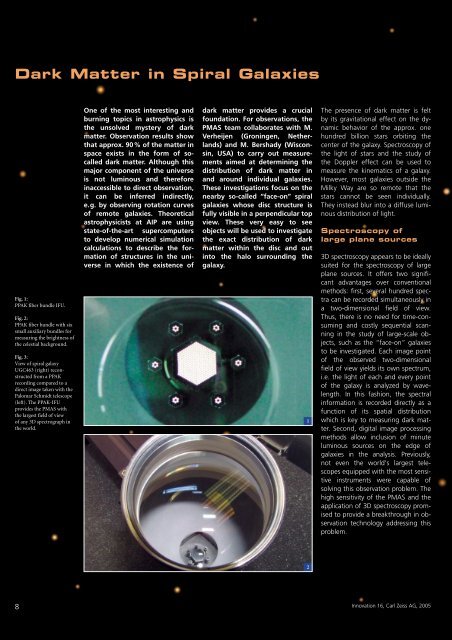Download PDF - Carl Zeiss
Download PDF - Carl Zeiss
Download PDF - Carl Zeiss
Create successful ePaper yourself
Turn your PDF publications into a flip-book with our unique Google optimized e-Paper software.
Dark Matter in Spiral Galaxies<br />
Fig. 1:<br />
PPAK fiber bundle IFU.<br />
Fig. 2:<br />
PPAK fiber bundle with six<br />
small auxiliary bundles for<br />
measuring the brightness of<br />
the celestial background.<br />
Fig. 3:<br />
View of spiral galaxy<br />
UGC463 (right) reconstructed<br />
from a PPAK<br />
recording compared to a<br />
direct image taken with the<br />
Palomar Schmidt telescope<br />
(left). The PPAK-IFU<br />
provides the PMAS with<br />
the largest field of view<br />
of any 3D spectrograph in<br />
the world.<br />
8<br />
One of the most interesting and<br />
burning topics in astrophysics is<br />
the unsolved mystery of dark<br />
matter. Observation results show<br />
that approx. 90% of the matter in<br />
space exists in the form of socalled<br />
dark matter. Although this<br />
major component of the universe<br />
is not luminous and therefore<br />
inaccessible to direct observation,<br />
it can be inferred indirectly,<br />
e.g. by observing rotation curves<br />
of remote galaxies. Theoretical<br />
astrophysicists at AIP are using<br />
state-of-the-art supercomputers<br />
to develop numerical simulation<br />
calculations to describe the formation<br />
of structures in the universe<br />
in which the existence of<br />
dark matter provides a crucial<br />
foundation. For observations, the<br />
PMAS team collaborates with M.<br />
Verheijen (Groningen, Netherlands)<br />
and M. Bershady (Wisconsin,<br />
USA) to carry out measurements<br />
aimed at determining the<br />
distribution of dark matter in<br />
and around individual galaxies.<br />
These investigations focus on the<br />
nearby so-called “face-on” spiral<br />
galaxies whose disc structure is<br />
fully visible in a perpendicular top<br />
view. These very easy to see<br />
objects will be used to investigate<br />
the exact distribution of dark<br />
matter within the disc and out<br />
into the halo surrounding the<br />
galaxy.<br />
1<br />
2<br />
The presence of dark matter is felt<br />
by its gravitational effect on the dynamic<br />
behavior of the approx. one<br />
hundred billion stars orbiting the<br />
center of the galaxy. Spectroscopy of<br />
the light of stars and the study of<br />
the Doppler effect can be used to<br />
measure the kinematics of a galaxy.<br />
However, most galaxies outside the<br />
Milky Way are so remote that the<br />
stars cannot be seen individually.<br />
They instead blur into a diffuse luminous<br />
distribution of light.<br />
Spectroscopy of<br />
large plane sources<br />
3D spectroscopy appears to be ideally<br />
suited for the spectroscopy of large<br />
plane sources. It offers two significant<br />
advantages over conventional<br />
methods: first, several hundred spectra<br />
can be recorded simultaneously in<br />
a two-dimensional field of view.<br />
Thus, there is no need for time-consuming<br />
and costly sequential scanning<br />
in the study of large-scale objects,<br />
such as the “face-on” galaxies<br />
to be investigated. Each image point<br />
of the observed two-dimensional<br />
field of view yields its own spectrum,<br />
i.e. the light of each and every point<br />
of the galaxy is analyzed by wavelength.<br />
In this fashion, the spectral<br />
information is recorded directly as a<br />
function of its spatial distribution<br />
which is key to measuring dark matter.<br />
Second, digital image processing<br />
methods allow inclusion of minute<br />
luminous sources on the edge of<br />
galaxies in the analysis. Previously,<br />
not even the world's largest telescopes<br />
equipped with the most sensitive<br />
instruments were capable of<br />
solving this observation problem. The<br />
high sensitivity of the PMAS and the<br />
application of 3D spectroscopy promised<br />
to provide a breakthrough in observation<br />
technology addressing this<br />
problem.<br />
Innovation 16, <strong>Carl</strong> <strong>Zeiss</strong> AG, 2005
















